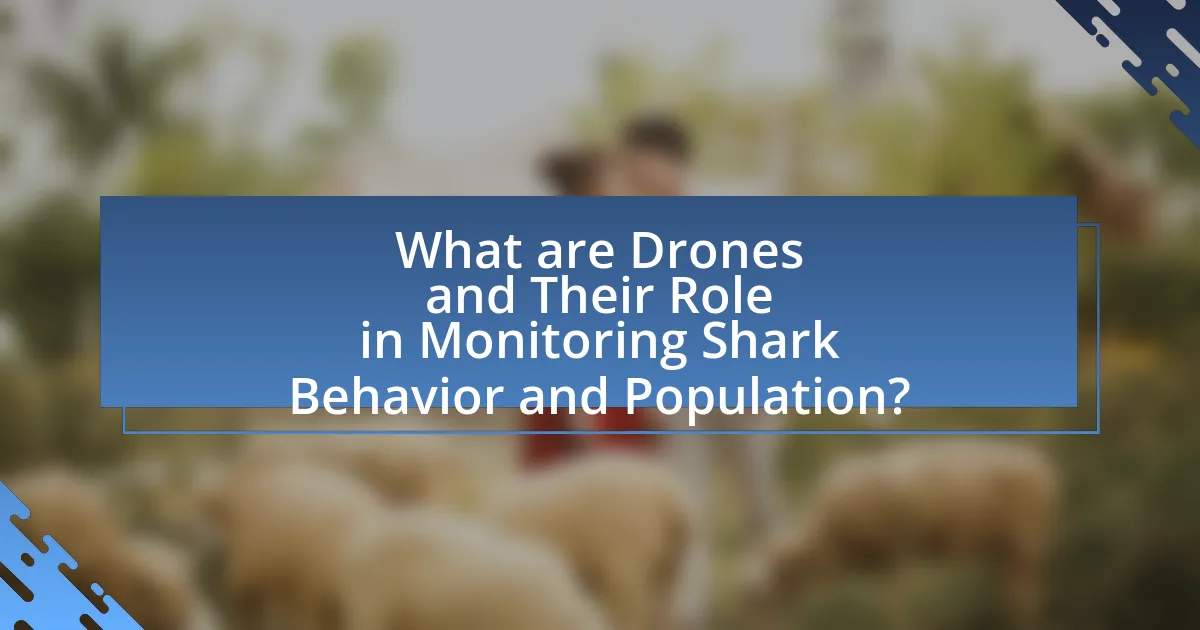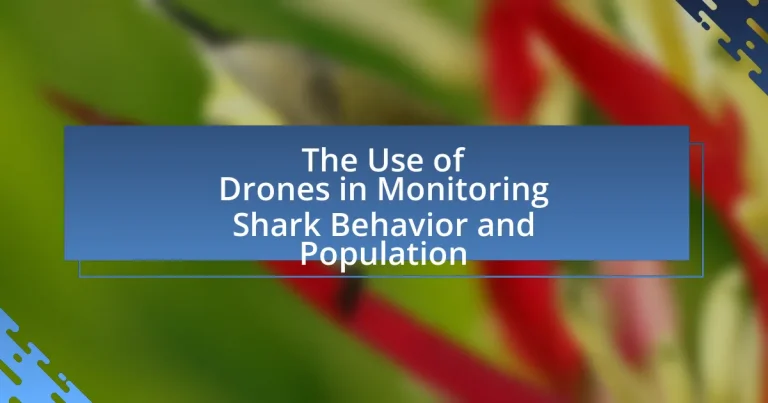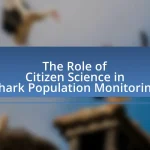Drones, or unmanned aerial vehicles, are increasingly utilized in monitoring shark behavior and population dynamics, providing researchers with a non-invasive method to collect data on shark distribution, movement patterns, and ecological impacts. Equipped with advanced technologies such as high-resolution cameras and thermal imaging sensors, drones enhance data collection efficiency and accuracy compared to traditional methods. This article explores the operational capabilities of drones in marine environments, the advantages they offer for shark monitoring, the challenges faced in their deployment, and the ethical considerations associated with their use. Additionally, it highlights the critical role of sharks in marine ecosystems and the importance of effective monitoring for conservation efforts.

What are Drones and Their Role in Monitoring Shark Behavior and Population?
Drones are unmanned aerial vehicles equipped with cameras and sensors that play a crucial role in monitoring shark behavior and population. They provide researchers with the ability to conduct aerial surveys, enabling the collection of data on shark distribution, movement patterns, and population dynamics without disturbing marine life. Studies have shown that drones can cover large areas quickly and efficiently, allowing for real-time monitoring and data collection, which is essential for conservation efforts and understanding ecological impacts. For instance, a study published in the journal “Marine Biology” demonstrated that drone technology significantly improved the accuracy of shark population assessments compared to traditional methods.
How do drones operate in marine environments?
Drones operate in marine environments by utilizing advanced technology to capture aerial imagery and collect data over water bodies. These unmanned aerial vehicles (UAVs) are equipped with high-resolution cameras and sensors that allow for real-time monitoring of marine life, including sharks. For instance, drones can fly at various altitudes and cover large areas quickly, providing researchers with valuable insights into shark behavior and population dynamics. Studies have shown that drones can effectively identify and track shark movements, enabling better understanding of their habitats and migration patterns. This capability is crucial for conservation efforts and managing shark populations, as it allows for non-invasive observation without disturbing the marine ecosystem.
What technologies are integrated into drones for marine monitoring?
Drones for marine monitoring integrate technologies such as high-resolution cameras, thermal imaging sensors, GPS, and LiDAR. High-resolution cameras enable detailed visual assessments of marine life, while thermal imaging sensors allow for the detection of temperature variations, which can indicate the presence of sharks. GPS technology provides precise location data for tracking movements and behaviors, and LiDAR offers detailed topographical mapping of underwater environments. These technologies collectively enhance the ability to monitor shark populations and behaviors effectively, as evidenced by studies demonstrating improved tracking accuracy and data collection efficiency in marine ecosystems.
How do drones collect data on shark behavior?
Drones collect data on shark behavior primarily through aerial surveillance and advanced imaging technologies. Equipped with high-resolution cameras and sensors, drones can monitor shark movements, feeding patterns, and interactions with other marine life from above, providing real-time data without disturbing the animals. Studies have shown that drones can cover large areas quickly, allowing researchers to gather extensive data on shark populations and their behaviors in various habitats, such as coastal regions and open waters. This method enhances traditional monitoring techniques, offering a non-invasive approach that minimizes human impact on the sharks and their environment.
Why is monitoring shark behavior and population important?
Monitoring shark behavior and population is crucial for maintaining marine ecosystem health and ensuring species conservation. Sharks play a vital role as apex predators, helping to regulate the populations of other marine species, which in turn maintains the balance of the ecosystem. Research indicates that overfishing and habitat loss have led to significant declines in shark populations, with some species experiencing reductions of over 90% in certain regions. By tracking their behavior and population dynamics, scientists can assess the impact of environmental changes, human activities, and conservation efforts, enabling informed management strategies to protect these essential species and their habitats.
What ecological roles do sharks play in marine ecosystems?
Sharks play crucial ecological roles in marine ecosystems as apex predators, helping to maintain the balance of marine life. By preying on various species, sharks regulate fish populations, which in turn supports the health of coral reefs and seagrass beds. For instance, studies have shown that the removal of sharks can lead to an overpopulation of smaller fish species, resulting in the depletion of important herbivores that graze on algae, thereby disrupting the entire ecosystem. Additionally, sharks contribute to nutrient cycling through their feeding habits and waste, which supports a diverse range of marine organisms.
How does shark population health impact biodiversity?
Shark population health significantly impacts biodiversity by maintaining the balance of marine ecosystems. Healthy shark populations regulate the populations of prey species, such as smaller fish and invertebrates, which in turn supports the overall health of coral reefs and seagrass beds. For instance, studies have shown that areas with healthy shark populations experience greater biodiversity and resilience in marine habitats, as sharks help control the abundance of herbivorous fish that can overgraze on vital vegetation. This ecological role underscores the importance of sharks in preserving the intricate web of life in ocean environments.

What are the Advantages of Using Drones for Shark Monitoring?
The advantages of using drones for shark monitoring include enhanced surveillance capabilities, cost-effectiveness, and reduced disturbance to marine life. Drones provide a bird’s-eye view, allowing researchers to cover large areas quickly and efficiently, which is crucial for tracking shark populations and behaviors. Studies have shown that aerial monitoring can increase detection rates of sharks compared to traditional methods, such as boats or divers, which can be limited by visibility and accessibility. Additionally, drones minimize human presence in the water, reducing stress on sharks and improving the accuracy of behavioral observations.
How do drones enhance data collection compared to traditional methods?
Drones enhance data collection in monitoring shark behavior and population by providing high-resolution aerial imagery and real-time data access, which traditional methods cannot match. Unlike boats or divers, drones can cover large areas quickly and efficiently, capturing detailed visual data without disturbing marine life. For instance, studies have shown that drones can survey up to 100 times more area than traditional methods in the same amount of time, significantly increasing the volume of data collected. Additionally, drones can operate in challenging environments, such as rough seas or remote locations, where human access is limited, thus expanding the scope of data collection efforts.
What specific data can drones gather that is beneficial for shark research?
Drones can gather specific data beneficial for shark research, including real-time population counts, behavioral patterns, and habitat usage. By utilizing high-resolution cameras and sensors, drones can monitor shark movements, identify species, and assess their interactions with the environment. For instance, a study published in the journal “Marine Biology” demonstrated that drones effectively tracked the movements of tiger sharks in the Bahamas, providing insights into their feeding habits and migratory patterns. This data is crucial for understanding shark populations and informing conservation efforts.
How do drones improve the safety of researchers in the field?
Drones improve the safety of researchers in the field by allowing them to conduct observations from a distance, minimizing direct exposure to potentially dangerous environments. For instance, when monitoring shark behavior, drones can capture aerial footage and gather data without researchers needing to enter the water, thereby reducing the risk of shark encounters. Additionally, drones can be equipped with thermal imaging and other sensors to detect hazards, such as strong currents or marine wildlife, before researchers approach an area. This capability enhances situational awareness and enables researchers to make informed decisions about their safety while conducting fieldwork.
What cost benefits do drones provide for shark monitoring initiatives?
Drones provide significant cost benefits for shark monitoring initiatives by reducing the need for expensive manned aircraft and extensive field personnel. The operational costs of drones are considerably lower, with estimates showing that drone flights can be up to 90% cheaper than traditional aerial surveys. Additionally, drones can cover large areas quickly and efficiently, allowing for more frequent monitoring without the associated high costs of fuel and maintenance for boats or planes. This efficiency leads to better data collection on shark populations and behaviors, ultimately enhancing conservation efforts while minimizing financial expenditure.
How do drones reduce operational costs in marine research?
Drones reduce operational costs in marine research by minimizing the need for manned vessels and extensive equipment. Traditional marine research often requires expensive boats, fuel, and crew, while drones can cover large areas quickly and efficiently at a fraction of the cost. For instance, a study by the University of California, Santa Barbara, found that using drones for aerial surveys can reduce costs by up to 80% compared to conventional methods. Additionally, drones can collect high-resolution data and images, which enhances research quality without the associated high costs of deploying larger research teams and equipment.
What are the long-term financial implications of using drones for monitoring?
The long-term financial implications of using drones for monitoring shark behavior and population include reduced operational costs and increased data accuracy. Drones significantly lower expenses associated with traditional monitoring methods, such as manned aircraft or boats, which can incur high fuel and labor costs. For instance, a study by the National Oceanic and Atmospheric Administration (NOAA) found that drone usage can reduce monitoring costs by up to 80% compared to conventional methods. Additionally, drones provide high-resolution imagery and real-time data, enhancing the quality of information collected, which can lead to more effective conservation strategies and better resource allocation. This improved data accuracy can result in long-term savings by optimizing management practices and reducing the need for costly corrective measures in shark population management.

What Challenges Are Associated with Using Drones in Shark Monitoring?
The challenges associated with using drones in shark monitoring include technical limitations, regulatory restrictions, and environmental factors. Technical limitations involve battery life and payload capacity, which can restrict flight duration and the types of sensors that can be used. Regulatory restrictions often require permits and adherence to aviation laws, which can complicate deployment. Environmental factors, such as weather conditions and oceanic visibility, can affect the effectiveness of drone operations. For instance, high winds or rain can hinder drone performance, making it difficult to capture accurate data on shark populations.
What technical limitations do drones face in marine environments?
Drones face several technical limitations in marine environments, primarily due to harsh weather conditions, limited battery life, and challenges with signal transmission. Harsh weather, including high winds and saltwater exposure, can impair drone functionality and durability, leading to potential malfunctions. Additionally, the battery life of drones is often insufficient for extended monitoring tasks, particularly over vast ocean areas where recharging or swapping batteries is impractical. Signal transmission can also be problematic, as drones may experience interference or loss of connection when operating over water, which can hinder real-time data collection and control. These limitations significantly impact the effectiveness of drones in monitoring shark behavior and population in marine settings.
How does weather affect drone operations in shark monitoring?
Weather significantly impacts drone operations in shark monitoring by affecting visibility, battery performance, and flight stability. For instance, high winds can lead to unstable flight conditions, making it difficult for drones to maintain a steady position while capturing images or data. Additionally, rain or fog can reduce visibility, hindering the drone’s ability to detect sharks and accurately monitor their behavior. Research indicates that drones operate optimally in temperatures between 15°C and 30°C; extreme temperatures can lead to reduced battery efficiency, limiting flight time and operational range. Therefore, understanding weather conditions is crucial for effective drone deployment in shark monitoring.
What are the limitations of drone battery life in extensive monitoring?
Drone battery life significantly limits the duration and range of extensive monitoring activities. Most commercial drones have a flight time ranging from 20 to 40 minutes, which restricts their ability to cover large areas or conduct prolonged observations. For instance, a study by the University of Southern California found that drones used for wildlife monitoring often require frequent recharging or battery swaps, which can interrupt data collection and reduce overall efficiency. Additionally, environmental factors such as temperature and wind can further decrease battery performance, leading to shorter operational times. These limitations necessitate careful planning and may require the use of multiple drones or supplementary power sources to achieve comprehensive monitoring objectives.
What ethical considerations arise from using drones for wildlife monitoring?
Using drones for wildlife monitoring raises several ethical considerations, primarily concerning animal welfare, privacy, and environmental impact. The deployment of drones can cause stress to wildlife, particularly if they are startled or disturbed during critical life stages, such as breeding or feeding. Research indicates that certain species exhibit stress responses to aerial surveillance, which can affect their behavior and overall health. Additionally, the use of drones may infringe on the privacy of individuals in remote areas, as drones can inadvertently capture images or data beyond the intended monitoring scope. Furthermore, the environmental impact of drone operations, including noise pollution and potential habitat disruption, must be considered, as these factors can alter ecosystems and affect species interactions. These ethical concerns necessitate careful planning and adherence to guidelines to minimize negative consequences while utilizing drone technology for wildlife monitoring.
How do drones impact shark behavior during monitoring?
Drones impact shark behavior during monitoring by altering their movement patterns and increasing their stress levels. Research indicates that the presence of drones can cause sharks to exhibit avoidance behavior, leading them to swim deeper or move away from the area being monitored. A study published in the journal “Marine Ecology Progress Series” by McIntosh et al. (2019) found that sharks displayed significant changes in their swimming behavior when drones were present, suggesting that aerial monitoring can influence their natural activities. This behavioral response is critical for researchers to consider when using drones for effective shark population assessments.
What regulations govern the use of drones in marine environments?
The use of drones in marine environments is primarily governed by regulations set forth by the Federal Aviation Administration (FAA) in the United States, which mandates that drone operators must adhere to Part 107 of the Federal Aviation Regulations. This includes requirements for remote pilot certification, operational limitations, and restrictions on flying over people and in certain airspace. Additionally, the National Oceanic and Atmospheric Administration (NOAA) imposes specific guidelines for drone use in marine protected areas to ensure the safety of wildlife, including sharks. These regulations are designed to minimize disturbances to marine ecosystems and protect sensitive species.
What are best practices for effectively using drones in shark monitoring?
Best practices for effectively using drones in shark monitoring include ensuring proper flight planning, utilizing high-resolution cameras, and adhering to local regulations. Proper flight planning involves selecting optimal times for monitoring, such as early morning or late afternoon when shark activity is higher. High-resolution cameras enhance the ability to identify species and count populations accurately, as demonstrated by studies showing improved detection rates with advanced imaging technology. Adhering to local regulations ensures compliance with wildlife protection laws and minimizes disturbances to marine life, which is crucial for ethical monitoring practices.
How can researchers ensure data accuracy when using drones?
Researchers can ensure data accuracy when using drones by implementing rigorous calibration protocols and utilizing high-resolution sensors. Calibration of drones before data collection helps to minimize errors related to altitude, positioning, and sensor performance. High-resolution sensors, such as RGB cameras and thermal imaging devices, provide detailed imagery that enhances the precision of data captured. Additionally, researchers can cross-verify drone data with ground truth measurements, which involves collecting data from the field to validate the drone’s findings. Studies have shown that combining drone data with traditional survey methods increases the reliability of population estimates and behavioral observations in marine environments, including shark monitoring.
What strategies can enhance the effectiveness of drone monitoring programs?
Implementing advanced data analytics and machine learning algorithms can significantly enhance the effectiveness of drone monitoring programs. These technologies enable the processing of large volumes of aerial imagery and sensor data, allowing for more accurate identification and tracking of shark populations. For instance, a study published in the journal “Remote Sensing” demonstrated that machine learning models improved species classification accuracy by over 90% when analyzing drone-captured images of marine life. Additionally, integrating real-time data transmission systems can facilitate immediate decision-making and response to observed behaviors, further optimizing monitoring efforts.


